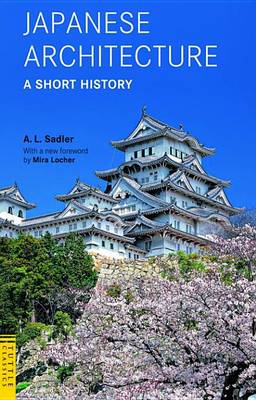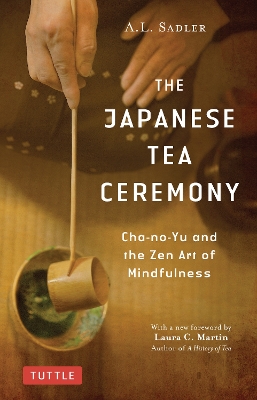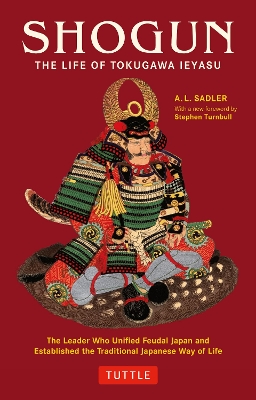Tuttle Classics
4 total works
This expert guide to Japanese architecture is of enormous historical importance to the understanding of Japanese design and culture.
Pioneering Japanologist A. L. Sadler's invaluable study of Japanese architecture first appeared in 1941. Considered a classic in its field, unequaled in clarity and insight, Japanese Architecture A Short History is a lucid and uncomplicated introduction to this important aspect of Japanese culture. Beginning with the earliest evidence from prehistory and ending with the Edo period, when Japan attained stature as a modern state, Japanese Architecture is as relevant today as it was in 1941.
The book includes an overview of Japanese domestic architecture as it evolved through successive periods of history and perfected the forms so widely admired in the West. Of particular importance in this respect are the four concluding chapters, in which the distinctive features of the Japanese house are presented in clear detail. The architecture book also contains excellent illustrations, which show details of planning and construction.
Pioneering Japanologist A. L. Sadler's invaluable study of Japanese architecture first appeared in 1941. Considered a classic in its field, unequaled in clarity and insight, Japanese Architecture A Short History is a lucid and uncomplicated introduction to this important aspect of Japanese culture. Beginning with the earliest evidence from prehistory and ending with the Edo period, when Japan attained stature as a modern state, Japanese Architecture is as relevant today as it was in 1941.
The book includes an overview of Japanese domestic architecture as it evolved through successive periods of history and perfected the forms so widely admired in the West. Of particular importance in this respect are the four concluding chapters, in which the distinctive features of the Japanese house are presented in clear detail. The architecture book also contains excellent illustrations, which show details of planning and construction.
Classic works from Noh, Kyogen, and Kabuki theaters
Nothing reflects the beauty of life as much as Japanese theater. It is here that reality is held suspended and the mind is filled with words, music, dance, and mysticism. In this groundbreaking book, Professor A.L. Sadler's translations come alive, bringing the mysteries of Noh, Kyogen, and Kabuki to modern readers worldwide. This influential classic provides a cross-section of Japanese theater that gives the reader a sampler of its beauty and power.
Sadler includes 40 plays spanning the following three genres:
Noh-As the oldest form of Japanese drama, Noh is remarkable for its unique staging. It has a powerful ability to create a world that represents the iconic attributes that the Japanese hold in the highest esteem: family, patriotism, and honor.
Kyogen-Kyogen plays provide comic relief and typically center around the inversion of social hierarchies. Oftentimes, they are performed between the serious and stoic Noh plays. Similarly, Sadler's translated Kyogen pieces are layered between the Noh and the Kabuki plays in this book.
Kabuki - The Kabuki plays were the theater of the common people of Japan and are characterized by visual spectacle. The course of time has given them the patina of folk art, making them precious cultural relics of Japan. Sadler selected these pieces for translation because of their lighter subject matter and relatively upbeat endings. These plays are more linear in their telling and pedestrian in the lessons learned, and show the difficulties of being in love when a society is bent on conformity and paternal rule.
The end result found in Japanese Plays is a wonderful selection of classic Japanese dramatic literature sure to enlighten and delight.
Nothing reflects the beauty of life as much as Japanese theater. It is here that reality is held suspended and the mind is filled with words, music, dance, and mysticism. In this groundbreaking book, Professor A.L. Sadler's translations come alive, bringing the mysteries of Noh, Kyogen, and Kabuki to modern readers worldwide. This influential classic provides a cross-section of Japanese theater that gives the reader a sampler of its beauty and power.
Sadler includes 40 plays spanning the following three genres:
The end result found in Japanese Plays is a wonderful selection of classic Japanese dramatic literature sure to enlighten and delight.
The Japanese Tea Ceremony is a detailed examination of the five-centuries-old tea ceremony-or Cha-no-Yu in Japanese, literally "hot water for tea"-a cornerstone of Japanese culture and a core practice of Zen Buddhism.
Framed by intricately choreographed steps, the tea ceremony is as much about the search for enlightenment as it is about serving tea. Within the serenity of the tea room, the ceremony, with its highly formal structure, becomes an object of focus for meditation. As the water is heated and the tea is served, the ultimate goal is losing the sense of self while gaining inner peace. The path to mindfulness runs through the center of the tea ceremony.
Abundantly illustrated with over 160 drawings and 40 color photos showing every aspect of the ceremony, this book takes readers on a complete tour of furniture and utensils, teahouses and gardens, and numerous other features of Cha-no-Yu. It also delves into the many disciplines included within the broader framework of the tea ceremony-Japanese art, calligraphy, flower arrangements, architecture, gardening, and exquisite handicrafts. Learn more about the experiences of masters of the tea ceremony over the centuries and histories of the various schools and traditions of the art of tea. Full-color photos of tea bowls, teahouses, and gardens reveal the exquisite artistry of the cult of tea and this important Japanese tradition.
With a new foreword by award-winning author Laura C. Martin, The Japanese Tea Ceremony is a fascinating exploration of the ritual and Zen philosophy of one of Japan's greatest customs, truly "an epitome of Japanese civilization."
Framed by intricately choreographed steps, the tea ceremony is as much about the search for enlightenment as it is about serving tea. Within the serenity of the tea room, the ceremony, with its highly formal structure, becomes an object of focus for meditation. As the water is heated and the tea is served, the ultimate goal is losing the sense of self while gaining inner peace. The path to mindfulness runs through the center of the tea ceremony.
Abundantly illustrated with over 160 drawings and 40 color photos showing every aspect of the ceremony, this book takes readers on a complete tour of furniture and utensils, teahouses and gardens, and numerous other features of Cha-no-Yu. It also delves into the many disciplines included within the broader framework of the tea ceremony-Japanese art, calligraphy, flower arrangements, architecture, gardening, and exquisite handicrafts. Learn more about the experiences of masters of the tea ceremony over the centuries and histories of the various schools and traditions of the art of tea. Full-color photos of tea bowls, teahouses, and gardens reveal the exquisite artistry of the cult of tea and this important Japanese tradition.
With a new foreword by award-winning author Laura C. Martin, The Japanese Tea Ceremony is a fascinating exploration of the ritual and Zen philosophy of one of Japan's greatest customs, truly "an epitome of Japanese civilization."
This book tells the fascinating history of the life of Shogun Tokugawa Ieyasu - Japan's most famous Shogun.
Since its initial appearance, A.L.Sadler's imposing biography of the Japanese Shogun Tokugawa Ieyasu has been recognized as an outstanding contribution to the knowledge of Japanese history. It is also considered the standard reference work on the period that saw the entrenchment of feudalism in Japan and the opening of some two and a half centuries of rigid isolation from the rest of the world.
In the course of Japanese history, there have been five great military leaders who by common consent stand out above the others of their type. Of these, two lived in the twelfth century, while the other three, Oda Nobunaga, Toyotomi Hideyoshi, and Tokugawa Ieyasu, were contemporary in the latter half of the sixteenth century. The last of these three, with whose life Mr. Sadler deals, may well be described as having perfected the shogunate system. Not only did Ieyasu found a dynasty of rulers and organize a powerful system of government, but also he rounded off his achievements by contriving before his death to arrange for his deification afterward.
As Mr. Sadler notes, "Tokugawa Ieyasu is unquestionably one of the greatest men the world has yet seen," and this fascinating account of Ieyasu's life and times is presented in a thoroughly absorbing narrative in which dramatic highlights abound.
Japan's feudal age came to a close in 1868 with the downfall of the Tokugawa Shogunate and the restoration of the Emperor to political power. The event marked the end of the powerful regime that Ieyasu established at the beginning of the seventeenth century. That it did not at the same time mark the eclipse of Ieyasu's greatness is sufficient testimony to the major role he played in his country's history. It is to A. L. Sadler's lasting credit that he has brought this eminent but often ruthless military leader so vividly to life.
Since its initial appearance, A.L.Sadler's imposing biography of the Japanese Shogun Tokugawa Ieyasu has been recognized as an outstanding contribution to the knowledge of Japanese history. It is also considered the standard reference work on the period that saw the entrenchment of feudalism in Japan and the opening of some two and a half centuries of rigid isolation from the rest of the world.
In the course of Japanese history, there have been five great military leaders who by common consent stand out above the others of their type. Of these, two lived in the twelfth century, while the other three, Oda Nobunaga, Toyotomi Hideyoshi, and Tokugawa Ieyasu, were contemporary in the latter half of the sixteenth century. The last of these three, with whose life Mr. Sadler deals, may well be described as having perfected the shogunate system. Not only did Ieyasu found a dynasty of rulers and organize a powerful system of government, but also he rounded off his achievements by contriving before his death to arrange for his deification afterward.
As Mr. Sadler notes, "Tokugawa Ieyasu is unquestionably one of the greatest men the world has yet seen," and this fascinating account of Ieyasu's life and times is presented in a thoroughly absorbing narrative in which dramatic highlights abound.
Japan's feudal age came to a close in 1868 with the downfall of the Tokugawa Shogunate and the restoration of the Emperor to political power. The event marked the end of the powerful regime that Ieyasu established at the beginning of the seventeenth century. That it did not at the same time mark the eclipse of Ieyasu's greatness is sufficient testimony to the major role he played in his country's history. It is to A. L. Sadler's lasting credit that he has brought this eminent but often ruthless military leader so vividly to life.



